Kaurna, Meru, Banggarla, Nawu, Wirangu, Mirning Country.
Adelaide
The journey from Kangaroo Island to Adelaide is a relatively short one and so we arrived in the South Australian state capital early on a Friday afternoon. I had been on the road for exactly two weeks at this point, and it was great to have the food halls, restaurants and shopping of a large city available.
Continued from South Australia Part 3 of 4 – Kangaroo Island
Saturday morning, I visited Botanic Park between Adelaide Zoo and Botanic Gardens. This site adjacent to the River Torrens is home to relatively new addition to the city, a Grey-headed Flying Fox camp. Established in 2010 the colony now numbers an impressive 20,000 animals.
The Grey-headed Flying Fox is Australia’s only endemic and largest flying fox, reaching upto 1kg with a 1m wingspan. It is found throughout Eastern Australia including Qld, NSW, Vic, and SA, where they pollinate and disperse seeds essential for healthy forest ecosystems. Sadly, in common with many Australian mammals numbers are declining due to habitat clearance.
Each night the adults leave camp to fly between 20km and 50km to search for food. Unlike the smaller insectivorous bats, they use sight and smell to navigate and find food. They prefer native flower such as Eucalypt, Melaleuca and Banksia, but also eat native fruit like Lilly Pilly and Moreton Bay Figs. In the absence of natives they will feed on non-native fruits and flowers.
A fruit bat camp is a noisy affair and the squeals, shrieks and squabbles rent the crisp early morning air. Some bats roost high in the giant pine trees dotted throughout the park, but fortunately better views are possible when bats roost in the smaller casuarinas and fig trees.
Grey-headed Flying Fox.

Morialta Conservation Park.
Morialta Conservation Park, nestled into a fold of the Adelaide Hills, is a mere twenty minute drive from Adelaide CBD. The park is a paradise of waterfalls and walking trails and an early morning visit after recent rain, found the damp of the soil breathing up both rich and intoxicating.
Map showing location of Morialta Conservation Park.
Abundant Koalas are the main wildlife attraction, evidenced by the large number of visitors walking around with heads tilted skyward. In addtition to Koalas, Western Grey Kangaroos graze the hillsides while the gum trees were alive with a riot of colour, as Lorikeets and Rosellas flitted between the nesting hollows of the giant eucalypts.
Koalas in the giant gums on the valley floor of the First Falls Walk were too distant for clear views, and so I climbed the steep valley sides via the Second Falls Walk to where the trees were stunted. A Koala peered down from a low fork in a tree which unlike many of the Koalas that morning was quite awake.
Koala.

Brookfield Conservation Park
Brookfield Conservation Park sits on a semi-arid plain of bluebush, mallee and sugarbush and is an excellent place to look for the smallest of Australia’s three wombat species, the Southern Hairy-nosed Wombat. The park is only open to the public during daylight hours with rustic facilities, including two vehicle tracks, the Bluebush and Mallee Tracks that specify the respective vegetation communities the tracks pass through.
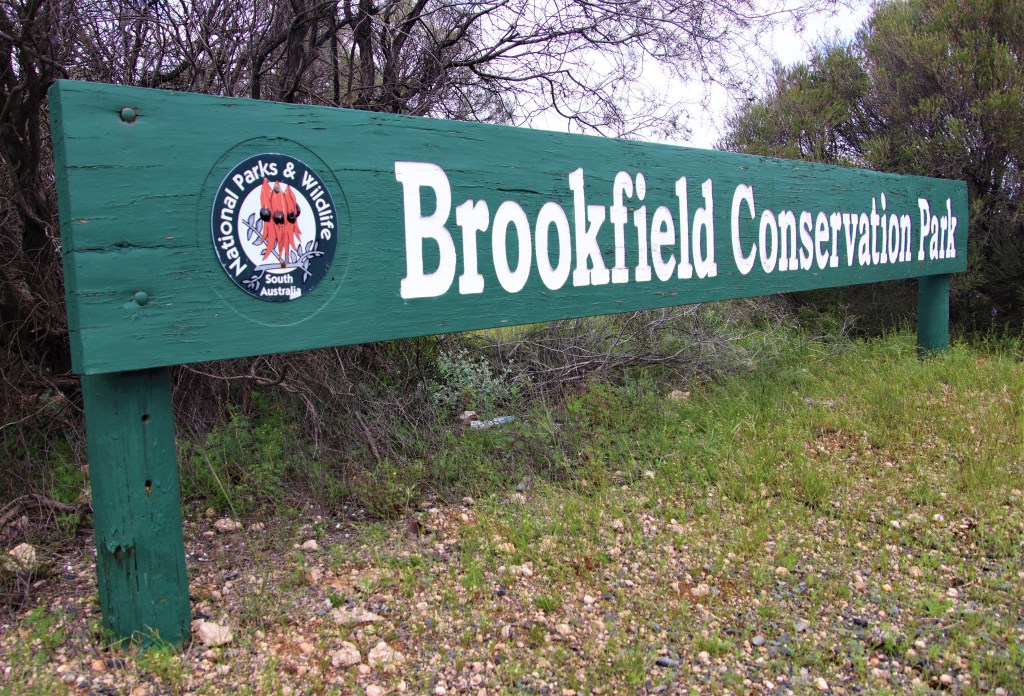
The short journey from Adelaide to Brookfield is a ninety minute one along the Northern Expressway from the city. The route joins the Sturt Highway as it passes over the Mount Lofty Ranges through the towns of Nuriootpa and Truro. The view across the vast semi-arid Cragie Plains on the winding descent is magnificent.
Map showing location of Brookfield Conservation Park.
A previous visit to Brookfield had revealed a solitary grazing Wombat just after the sun dipped below the horizon. This time Lorenz and I visited early afternoon on account of a front that had recently passed over the area. The day was cold and partly cloudy with short sunny spells and I was hopeful the Wombats would be displaying basking behaviour.
We crawled along the Bluebush Track at 15kph to minimise disturbance to any Wombats encountered. The topography of Brookfield is dotted with hundreds of Wombat burrows which provide protection from temperatures that can reach 50C during Summer.
Wombat Burrow.
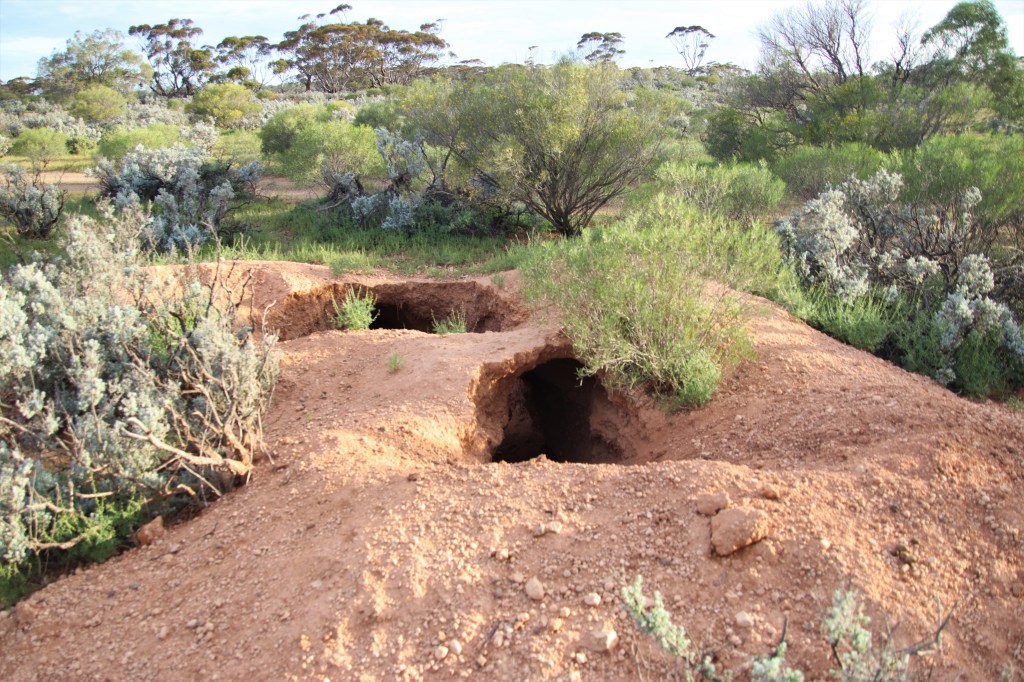
After half an hour of slow driving we found a well camouflaged sub-adult Wombat basking on the bare earth surrounding a burrow. I brought the car to a halt as the Wombat raised it’s head, but it didn’t seem alarmed. It is possible the wind may have acted favourably, mitigating the engine noise.
Wombat young are born in Spring and take 3 years to reach adulthood. The pouch opens backwards in common with other digging marsupials so the pouch young don’t receive a face full of dirt! The facial expression of a Southern hairy-nosed Wombat is doleful, almost funereal which serves to further endear an already delightful marsupial!
Juvenile Southern Hairy-nosed Wombat.

On our eventual departure the Wombat stood up and disappeared down the nearest burrow entrance. A Wombat burrow can contain upto ten Wombats and the species is unusual amongst mammals in that the males live with relatives.
We stretched our legs on the one kilometre Three Habitat Circular Loop Walk, which traverses stands of all three of Brookfield’s vegetation communities and close to active wombat burrows, indeed the clouds of dust eminating from a burrow indicated there were Wombats at home.
As we walked the track we encountered a Sleepy Lizard enjoying a brief sunny period.
Sleepy Lizard.

A number of Southern Hairy-nosed Wombats were basking near burrow entrances along the length of the Bluebush Track. Most alarmed by the movement and noise of the car quickly vanished down the nearest burrow entrance. The Wombat below was the exception, freezing, seemingly undecided on a course of action..
Southern Hairy-nosed Wombat.

Of the seven Wombats seen during the afternoon, five were basking and two seen prior to sunset were grazing in the late afternoon sun streaming in from the West. Western Grey and Red Kangaroos were also present in increasing numbers as the afternoon progressed. The day had exceeded all expectations for wildlife and was completed by an impressive sunset before the return drive to Adelaide.
Sunset – Brookfield Conservation Park.

Sunday was a pre-dawn start to begin the long journey back to Perth via the Gawler Ranges. After 5 hours I arrived in Kimba at lunchtime and stocked up on essential supplies before driving the final 100km North through farmland to the Gawler Ranges. The day was warm and sunny day enough for 10 Sleepy Lizards to be active. This included three pairs that had reunited for their annual mating. Another basking reptile briefly seen on the road was a Crested Bicycle Dragon.
Gawler Ranges National Park
Located on the Northern Eyre Peninsula is the Gawler Ranges National Park, which was only established in 2002 when the SA government puchased the pastoral lease of Paney Station. It is much less well-known National Park than the nearby Flinders Ranges, and as a result is delightfully uncrowded.
I had allowed four nights to explore the Gawlers. The abundance of Southern Hairy-nosed Wombats was a key reason to visit and prior to the trip I had e-mailed a helpful park ranger who advised the best place to see this species within the park was the LP 4WD Track.
I entered the Gawlers via Old Paney Homestead, which now serves as the rangers station and main information hub. This is also where the LP Track originates to traverse the parks North, through a landscape of grassy savannah and domed hills.
It was immediately obvious there is a healthy Emu population at the Gawlers. Off to one side of the track was an Emu Dad with a brood of eight adolescent chicks, on the opposite side two more Emu’s raised their heads from feeding, inquisitive as to the vehicle noise, while ahead a further three Emu’s strutted across the track.
Emu.

Kolay Hut Campground is one of six campgrounds in the Gawler Ranges. It is the only campsite on the LP Track and was where I planned to spend the first few nights. Investigation revealed a great campsite nestled in shade alongside a dry creek. There were fire pits at the small number of sites as well as an enclosed information hut.
The Gawler Ranges are a 1.5 billion year old landscape resulting from the eruption of a supervolcano. The evidence of this volcanic eruption is seen at nearby Kolay Mirica Falls where the geometric pattern of rocks is revealed, once the lava had cooled and fractured into hexagonal columns.
Kolay Mirica Falls.

The LP Track continues West from Kolay Mirica Falls, cresting a hill then descending a plain dotted with wombat burrows following a creekline to Pondanna Outstation.
Despite it being mid-afternoon and sunny conditions, Macropods had emerged to graze with both Wallaroos and Western Grey Kangaroos easily seen. After Pondanna Outstation the track climbs conical hill and becomes a rough 4WD track before connecting with Yardea Rd.
Aside from the LP Track the Iron Knob-Hilltaba Road running North of the park to Hiltaba Nature Reserve is another location reputed to be good for wombats. The habitat looked excellent with areas of bluebush, and while there were certainly wombat burrows the only wombats I saw were roadkill. Western Grey Kangaroos became increasingly common as afternoon became evening.
I had travelled too far to return to Kolay Hut Campground before dark, so I pulled off the road and set up camp behind some bushes. Once the last of the daylight had disappeared and darkness had fallen, the night sky came alive with a thousand shimmering stars.
I was woken at first light by birdsong somewhere on planet earth. It was a crisp morning and the underside of the high wispy cloud was illuminated pink by the rising sun. This cloud was the first sign of an approaching rain event.
Gawler Ranges.
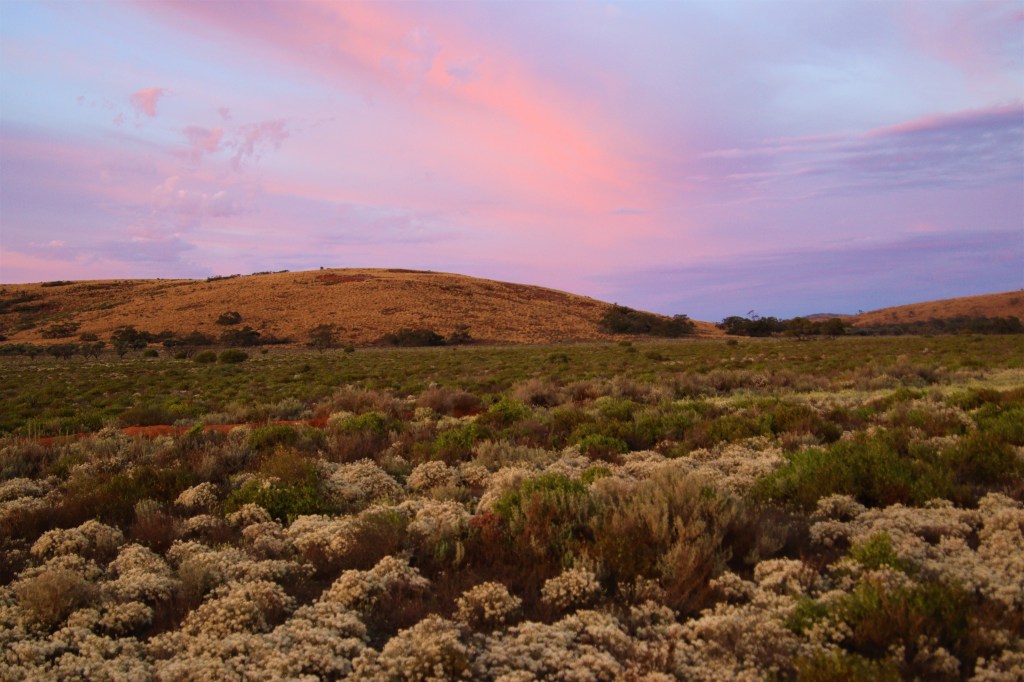
Prior to leaving internet coverage in Kimba, the latest weather forecast for the Gawlers had predicted a significant rain event by the third day. The rain was being pulled across the continent from the Indian Ocean in a Northwesterly flow and accordingly the actual rain totals were ambiguously quoted as 5mm to 15mm.
The Spring of 2022 had been a wet one for Australia’s Eastern States with many devastating flood events. While South Australia had been spared the worst of the weather for now (the Riverland Region would later flood as the Murray River burst its banks from the volume of water upstream,) it had still rained on average every second day of the trip.
It was particularly frustrating to see the Gawlers in fine weather when I was experiencing damp conditions on KI. Conversely now I was in the Gawlers about to experience a rain event, Kangaroo Island was under sunny skies.
The search for the Southern Hairy-nosed Wombats continued along Hiltaba-Iron Range Rd that morning again without success, but there were huge numbers of Western Grey Kangaroos including the large muscular male pictured below.
Western Grey Kangaroo.

In addition to the numerous Kangaroos a large stately, bird with brown plumage drew my attention. The Australian Bustard is a nomadic species that when detected typically walks cryptically away bill pointed skyward, only ever flying as a last resort. This behaviour I was very familiar with from my time living in Exmouth.
Unusually this bird persisted feeding, and so I turned off the engine and spent an extended period of time observing the foraging behavior. Bustards are omnivorous with the bulk of the diet consisting of insects and seeds, but they will eat lizards and frogs if the opportunity presents.
The species has greatly diminished in the South of the continent, which is a shame because they can be a great ally of farmers when controlling outbreaks of grasshoppers so damaging to crops.
Bustard.
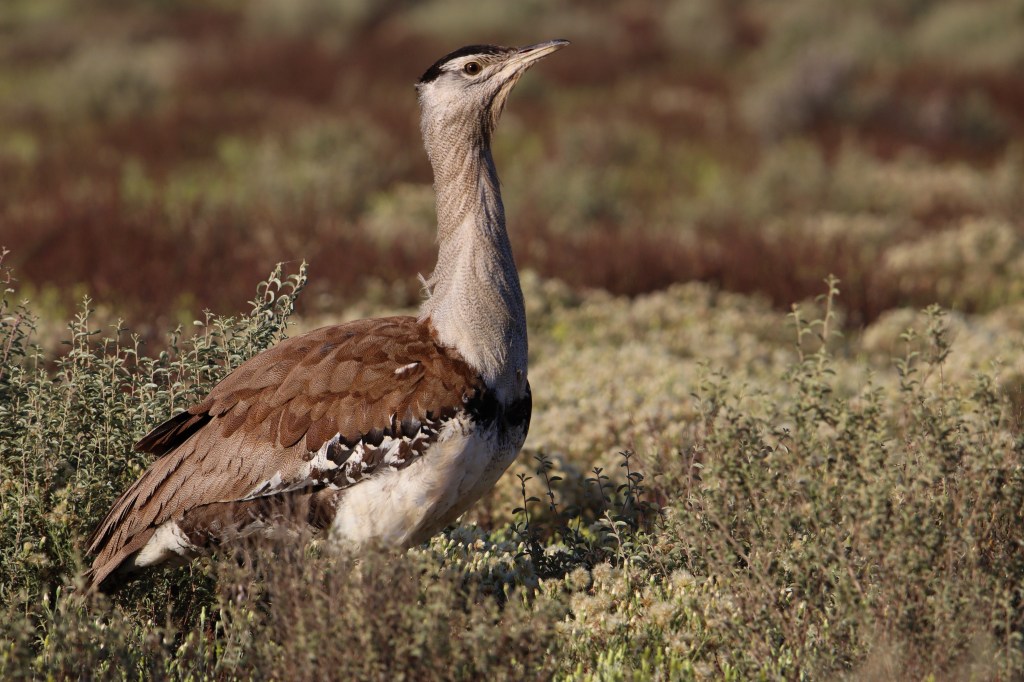
Further along the road another nomadic bird was in good numbers. Budgerigars feeding in the long grass flew up into the eucalypts on hearing the car engine.
Riverine eucalypt woodland on Yardea Road was providing nesting hollows for the Budgies. The confidence of the Budgies to nest in the Gawlers was further evidence that a wet Spring would provide sufficient food to raise the chicks.
Budgerigar.

The sky had begun to cloud over on the return drive along the LP Track to Kolay Hut Campground. On the track was a Sleepy Lizard with an exquisite dark colouration dapled with white spots. It was clearly enjoying the warmth from the stony ground, eyes closed in basking bliss.
Sleepy Lizard….well sleeping.

At the campground I set up the tent and napped and when I woke a thick blanket of cloud weighed heavily on the landscape.
During an afternoon drive along the LP Track a light drizzle progressively turned into heavier persistent rain. There was still a profusion of wildlife with mobs of Emus, and Wallaroos that had come down from the surrounding hills to graze the creekline.
Wallaroo.
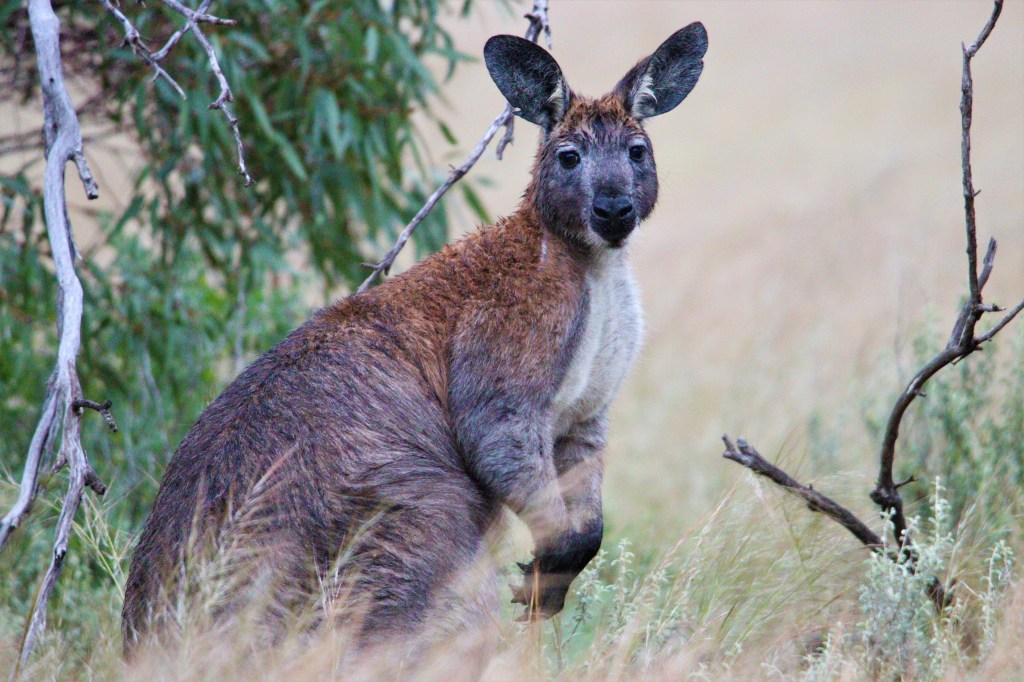
I turned around at Pondanna Outstation to return to the campground. The wildlife by now was starting to look decidedly soggy including the Western Grey Kangaroo pictured below.
Western Grey Kangaroo.

Back at the campground there was little choice other than to go to bed. I probably should have packed up knowing it is not recommended to drive the LP Track in adverse weather. I suppose I hoped against hope that the rain that afternoon was the extent of the system and conditions would improve the following morning.
I was woken at 11pm by heavy rain drumming on the tent, and it soon became clear this rain was here to stay. Procrastinating for the best part of an hour it became inevitable that I was going to need to get out of my warm sleeping bag and get the hell out of there before the track became impassable.
I threw eveything in the back of the Triton and set off through the darkness and rain. There were Western Grey Kangaroos grazing alongside the track, a timely reminder that despite the urgency, care and slow speed were required.
At Paney Homestead I was able to access phone reception and the weather forecast was looking grim. To drive a long distance out of the park in atrocious weather at a time when wildlife was most active would have been madness. Instead I headed for Waginny Campsite situated off the more substantial 2WD gravel road (Old Paney Scenic Drive) to wait for first light.
Waganny Campsite was utterly deserted in the deluge. There I selected a site where trees afforded some protection from the rain, and put up the already wet tent to enter the damp sleeping bag. It was 3am and exhausted I promptly fell back asleep to the rhythm of the rain.
At 7am it will still pouring when I packed the car once again. The Old Paney Scenic Drive despite being a clay and gravel road was waterlogged and contained the tyre tracks of a vehicle that had passed through during the night.
The slide marks and fish-tails on the road provided useful indicators by which to negotiate my exit, and apart from a few gnarly skids I made it past pools of water that had accumulated without incident, back on to tarmac and South to the town of Minnipa.
Had I delayed the exit from the Gawler Ranges any later, bogging would have been a real possibility….
The drive from Minnipa to Ceduna took the best part of two hours accompanied by the dank smell of wet camping gear. The first thing I did on arrival in Ceduna was book a room at the Foreshore Hotel. I had a few hours before I could check-in so I put them to good use drying the sopping tent on the foreshore in the stiff wind.
Once I had access to the motel room I cranked the heater and had a delicious nap after the pathetic four hours I had managed the previous night. The remainder of the afternoon was spent indulging in mindless daytime tv and drinking beer. It was perfect.
I wandered down to the jetty for sunset and although the sun was hidden behind cloud, the sky was a palatte of pinks and purples.
That night I climbed into bed thankful once again not to be camping. I had loved the short time I had spent in the Gawler Ranges but had hardly scratched the surface of this magnificent park. Disppointing as it was to have to cut the visit short, I know I will return there.
Ceduna Jetty.
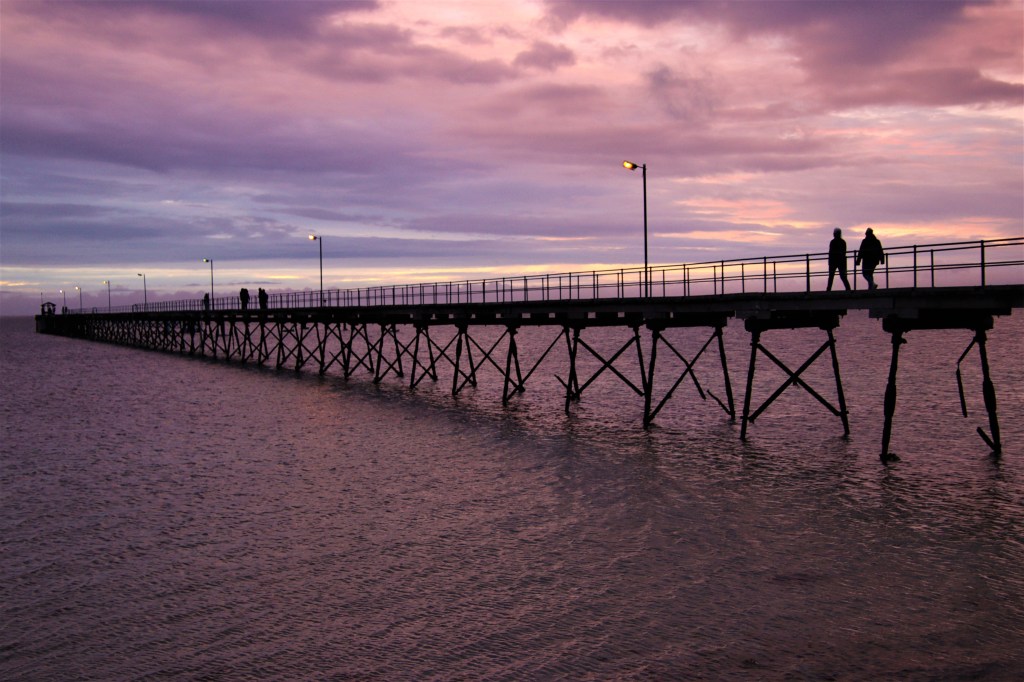
Appropriately, the name Ceduna comes from the indigenous word chedoona, which means resting place. It had certainly been that over the previous 24 hours. The following morning I downloaded a fresh load of podcasts to start the return leg across the Nullarbor.

After 73 kms there was a lovely rural outlook on the approach to the town of Penong consisting of silos and windmills.
Indeed Penong is celebrated for it’s windmills, with a windmill museum situated just off the highway in this tiny town of just 75 residents. The museum contains donated and restored windmills, including Australia’s biggest windmill affectionately known as Bruce. It was a delightful break.
Penong.

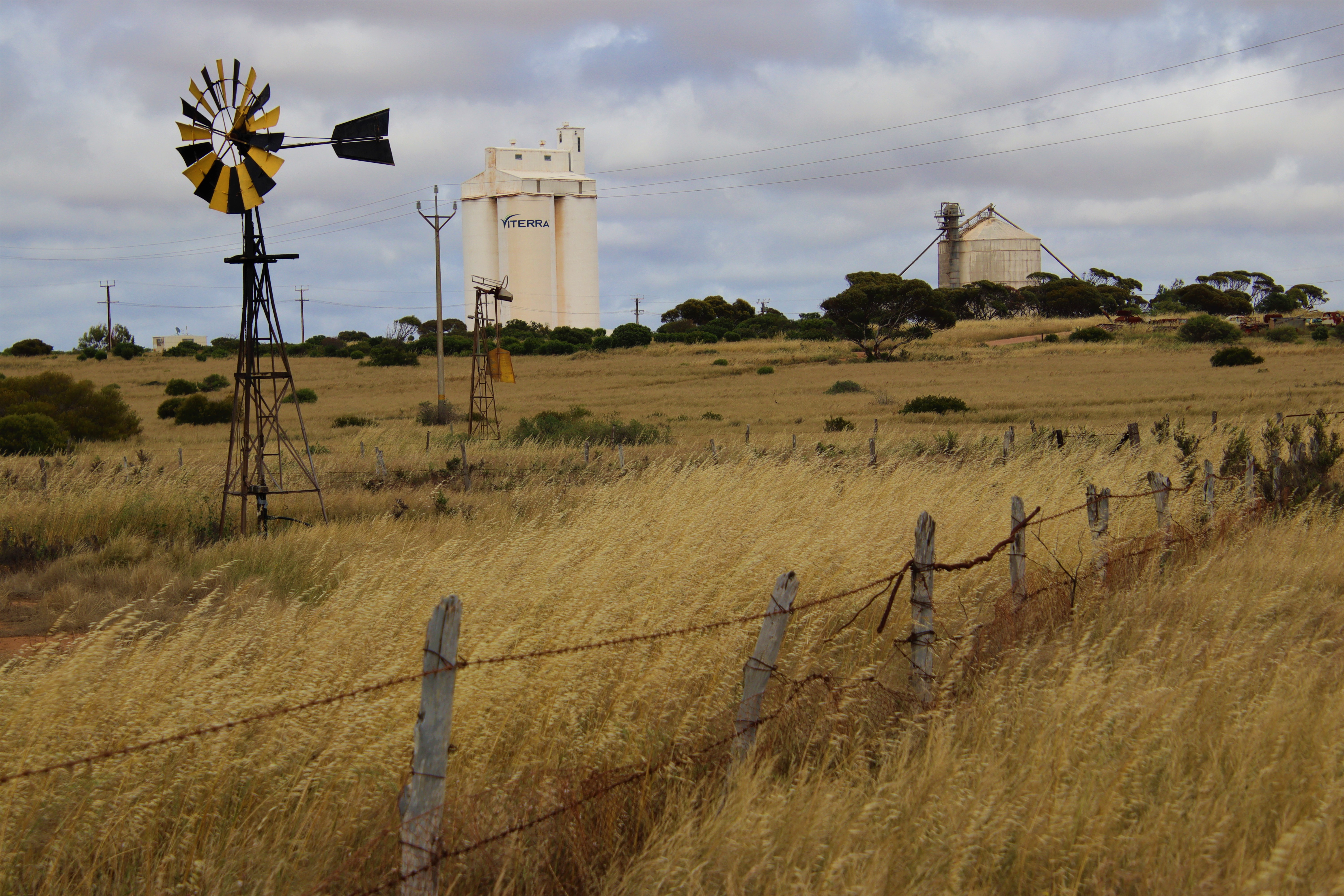

Fowlers Bay
After missing out on wombats in the Gawler Ranges I wanted to try for them on the return journey, and Fowlers Bay reputed to have good numbers provided an opportunity. The coastal town is 23 kms from the highway along Fowlers Bay Road.
The partly sealed road is in good condition and driving along there were numerous wombat burrows alongside the road and in surrounding farmland.
The town itself was pretty low key with a caravan park, jetty and seaweed strewn beach. I had intended to camp at nearby Scott Bay Campsite but the windy conditions was going to make camping on the coast quite unpleasant. Instead I returned along Fowlers Bay Road to Fowlers Conservation Park, pulled off into the mallee and bush-camped.
The increasingly warm temperatures post cold front had drawn Sleepy Lizards onto Fowlers Bay Road on the return drive from town, and while I sat in shade and read that afternoon I delighted in a visit from a Sleepy Lizard that wandered through camp.
Late that afternoon I drove Fowlers Bay Road to the highway and back looking for wombats. The only wombats I saw however were dead wombats, many at the entrances to their burrows. They had either been shot or poisoned, it was ghastly. I’m unsure as to whether the persecutors were landowners upset by the digging habit of the wombats, or just idiots shooting for pleasure.
Right on dusk I did encounter a live Wombat on the entrance to a burrow system, which froze briefly before quickly disappearing into the safety of the burrow.
The Southern Hairy-nosed Wombat is one of my absolute favourite marsupials. The long silky grey fur, pig-like snout and upright ears give them a charming appearance. Add to this that they are one of the most arid-adapted mammals on the planet. How anyone could want to shoot them really messes with my head.
Southern Hairy-nosed Wombat.

The Nullarbor Plain
The final day in South Australia I drove the remaining 200 kms to Nullarbor Roadhouse where I secured a room. That afternoon I returned to the Bunda Cliffs. The best lookout is 70kms West of Nullarbor Roadhouse and on the drive I found a different species of Bluetongue Lizard.
The Western Blue-tongued Lizard as the name suggests is found mainly in WA and the Western part of SA but there are outlier populations in the East of SA into Victoria and NSW.
Western Bluetongue.

The weather at the Bunda Cliffs couldn’t have differed more from the trip across. Instead of cold, mist and rain it was sunny under a cloudless sky. I spent the afternoon reading at the lookout with one of the most impressive views in Australia laid out before me. The edge of a continent tumbling into a vast blue abyss.
Bunda Cliffs.

Late afternoon I explored the tracks behind the roadhouse once again looking for Wombats but without success. After a shower I visited the roadhouse bar which was filled with an eclectic mix of people from all over Australia.
The contrast between the Nullarbor Roadhouse during daytime when it is heaving with both vehicles and people, and evening when it is deserted, with the exception of a few motel guests and long-distance truckies couldn’t be greater.
As I walked the roadhouse forecourt a couple of trucks pulled up and the drivers disappeared into the shower block leaving two mighty road trains side by side. The sun was low in a smoky sky and the light was fabulous.
Road Trains – Nullarbor Roadhouse.

As I wandered across the roadhouse forecourt to watch the setting sun I felt like the only person on the planet. The silence was deafening, the isolation was palpable and it was incredibly serene.
Standing there on the endless Nullarbor Plain I considered the trip in its entirety. While the weather had certainly made things challenging for much of the three weeks, the wildlife had been excellent and the places visited worthwhile. South Australia is a fabulous state and I knew it wouldn’t be long before my return.
#QuollingAround
Sunset Nullarbor Roadhouse.
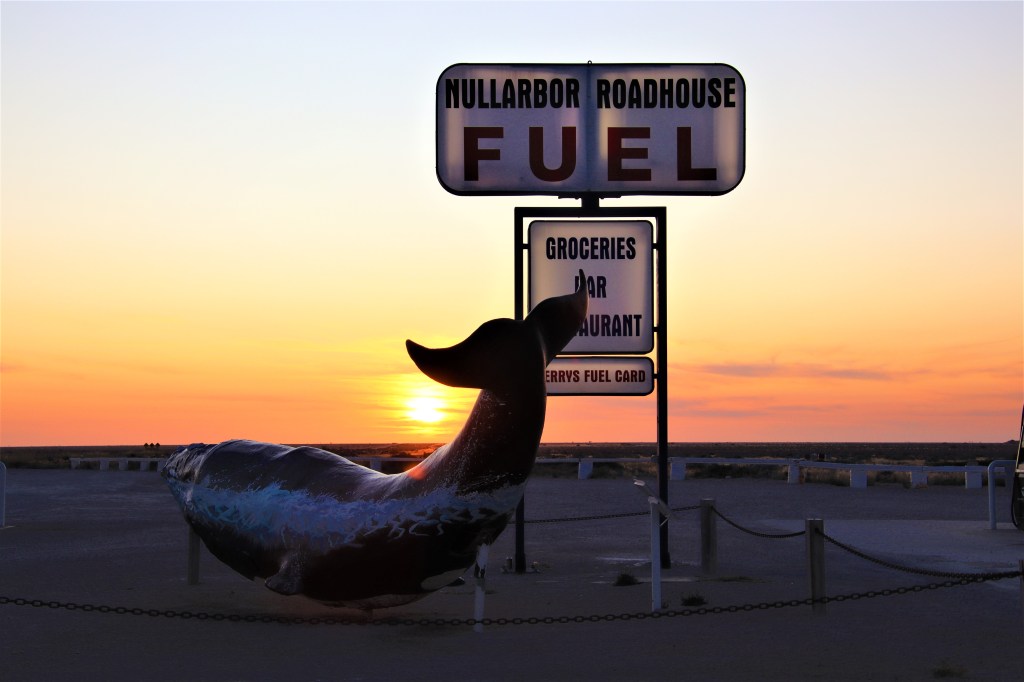
Thank you Jimmy for sharing your photos and experiences from travels to some rather remote and isolated regions. I could understand the urgency of getting out in time and the angst of getting bogged or skidding dangerously off the road in the Gawler Ranges. It was interesting to read about your encounters with the Southern Hairy-nosed Wombat and we found it difficult to understand why anyone would want to kill in mass such a harmless creature knowing how much the Wombat contributes to ploughing and loosening the earth so that seeds from grass and trees can germinate.
LikeLike
Hey Cheryl the dead wombats certainly took the shine off an otherwise excellent trip.
LikeLike
What an awesome trip you’ve had! I think every west Aussie dreams of a Nullarbor trip one day, myself included! I can’t believe people kill wombats though… that really upset me. I’ve never had a chance to see one in the wild. Thanks for sharing your wonderful photos and info!
LikeLike
Thanks for your kind words Anna. Yeah the wombat thing was really ghastly.
LikeLiked by 1 person
Ah, Jimmy, wonderful stuff again, How do you remember it all? Photos superb, and it bought back intense memories for me of my 8 or so trips across the Nullarbor. It is one of the great road trips in OZ. I loved that sign showing Perth as 1849 km away. It encapsulates the feeling of distance when travelling in OZ.
Camping in wet weather is a struggle, and getting bogged would freak me out. You need a hybrid Hilux fitted with a compact camper van setup with an outdoor awning and a comfortable chair. But that is Lotto win stuff.
LikeLike
Hey G, I seem to remember everything only because I carry a notebook in the field! Eight trips across the Nullarbor! I think that officially makes you a Nullarbor oracle!
LikeLike
For such a dry place, I also had to skip Gawler Ranges NP due to rain when I was nearby in 2018! Your inundated evacuation makes for a good story, but I’m sure it was horrible :-(. I didn’t know about Brookfield Conservation Park, but thanks for furthering my education. I’ll try there next time I’m in Adelaide as I missed the SHN wombats. It’s so sad that right across the country we have to witness areas of mammal carnage (a hangover from colonialism or just incurable stupidity?).
LikeLike